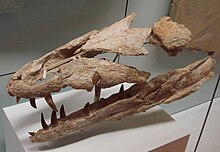| Dakosaurus | |
|---|---|

| |
| D. maximus neotype SMNS 8203, Staatliches Museum für Naturkunde Stuttgart | |
| Scientific classification | |
| Domain: | Eukaryota |
| Kingdom: | Animalia |
| Phylum: | Chordata |
| Class: | Reptilia |
| Clade: | Archosauria |
| Clade: | Pseudosuchia |
| Clade: | Crocodylomorpha |
| Clade: | Crocodyliformes |
| Suborder: | †Thalattosuchia |
| Family: | †Metriorhynchidae |
| Tribe: | †Geosaurini |
| Clade: | †Dakosaurina |
| Genus: | †Dakosaurus von Quenstedt, 1856[1] |
| Type species | |
| †Geosaurus maximus Plieninger, 1846
| |
| Species | |
| Synonyms | |
Dakosaurus is an extinct genus of crocodylomorph within the family Metriorhynchidae that lived during the Late Jurassic and Early Cretaceous. It was large, with teeth that were serrated and compressed lateromedially (flattened from side to side). The genus was established by Friedrich August von Quenstedt in 1856 for an isolated tooth named Geosaurus maximus by Theodor Plieninger in 1846.[2] Dakosaurus was a carnivore that spent much, if not all, its life out at sea. The extent of its adaptation to a marine lifestyle means that it is most likely that it mated at sea, but since no eggs or nests have been discovered that have been referred to Dakosaurus, whether it gave birth to live young at sea like dolphins and ichthyosaurs or came ashore like turtles is not known yet. The name Dakosaurus means "biter lizard", and is derived from the Greek dakos ("biter") and σαῦρος -sauros ("lizard").
- ^ Quenstedt FA. 1856. Sonst und Jetzt: Populäre Vortäge über Geologie. Tübingen: Laupp, 131.
- ^ a b c Plieninger T. 1846. Prof. Dr. Th. Plieninger hielt nachstehenden vortrag über ein neues Sauriergenus und die Einreihung der Saurier mit flachen, schneidenden Zähnen in eine Familie. Pp. 148-154 in: Zweite Generalversammlung am 1. Mai 1846 zu Tübingen. Württembergische naturwissenschaftliche Jahreshefte 2: 129-183.
- ^ Cite error: The named reference
Vignaud & Gasparini, 1996was invoked but never defined (see the help page). - ^ Cite error: The named reference
Sauvage, 1873was invoked but never defined (see the help page). - ^ Sauvage, H.-É., (1882), "Recherches sur les reptiles trouvés dans le Gault de l'est du bassin de Paris", Mémoires de la Société Géologique de France, série 3 2(4): 1-42
- ^ Bunzel, Emanuel (1871). "Die Reptilfauna der Gosauformation in der Neuen Welt bei Wiener-Neustadt" (PDF). Abhandlungen der Kaiserlich-königlichen Geologischen Reichsanstalt (in German). 5: 1–18. Retrieved 11 September 2013.